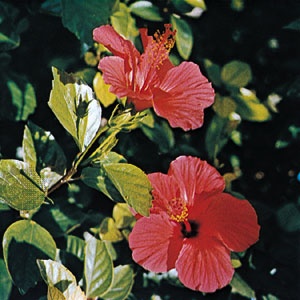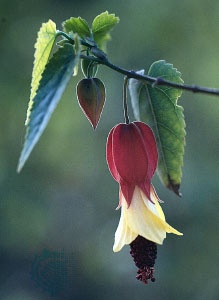hibiscus
plant
 any of about 350 species of herbs, shrubs, and trees constituting the genus Hibiscus, in the family Malvaceae, and native to warm temperate and tropical regions. Several are cultivated as ornamentals for their showy flowers.
any of about 350 species of herbs, shrubs, and trees constituting the genus Hibiscus, in the family Malvaceae, and native to warm temperate and tropical regions. Several are cultivated as ornamentals for their showy flowers.The tropical Chinese hibiscus, or China rose (H. rosa-sinensis), which may reach a height of 4.5 metres (15 feet), rarely exceeds 2 metres (6.5 feet) in cultivation. It is grown for its large, somewhat bell-shaped blossoms. Cultivated varieties have red, white, yellow, or orange flowers. The East African hibiscus (H. schizopetalus), a drooping shrub with deeply lobed, red petals, is often grown in hanging baskets indoors.
Other members of the genus Hibiscus include the fibre plants mahoe and kenaf, okra, musk mallow, rose of Sharon, and many flowering plants known by the common name mallow.
 Hibiscus now includes the former genus Abutilon, containing more than 100 species of herbaceous plants and partly woody shrubs native to tropical and warm temperate areas. Several species are used as houseplants and in gardens for their white to deep orange, usually nodding, five-petaled blossoms. H. hybridum, sometimes called Chinese lantern, is planted outdoors in warm regions and grown in greenhouses elsewhere. The trailing abutilon (H. megapotamicum), often grown as a hanging plant, is noted for its nodding, yellowish orange, closed flowers; it has a handsome variegated-leaf variety. H. pictum, a shrub reaching a height of 4.5 metres (15 feet), often called parlor, or flowering, maple, is grown as a houseplant. An important fibre plant in China is H. theophrastii, called China jute; it is a very serious field weed in the United States, where it is called velvetleaf or Indian mallow.
Hibiscus now includes the former genus Abutilon, containing more than 100 species of herbaceous plants and partly woody shrubs native to tropical and warm temperate areas. Several species are used as houseplants and in gardens for their white to deep orange, usually nodding, five-petaled blossoms. H. hybridum, sometimes called Chinese lantern, is planted outdoors in warm regions and grown in greenhouses elsewhere. The trailing abutilon (H. megapotamicum), often grown as a hanging plant, is noted for its nodding, yellowish orange, closed flowers; it has a handsome variegated-leaf variety. H. pictum, a shrub reaching a height of 4.5 metres (15 feet), often called parlor, or flowering, maple, is grown as a houseplant. An important fibre plant in China is H. theophrastii, called China jute; it is a very serious field weed in the United States, where it is called velvetleaf or Indian mallow.- and disease associated with genes for blood group systems Chromosome location, gene linkage
- Andean Community
- Andean Geosyncline
- Andean peoples
- Anders Adolf Retzius
- Anders Celsius
- Anders Danielsson
- Andersen, Hans Christian
- Andersen, Hjallis
- Andersen Nexø, Martin
- Andersen's disease
- Andersen, Tryggve
- Anders Gustav Ekeberg
- Anders Jonas Ångström
- Anderson
- Anderson, Carl David
- Anderson, Dame Judith
- Anderson, Elda Emma
- Anderson, Elizabeth Garrett
- Anderson, Gillian
- Anderson, Helen Eugenie Moore
- Anderson, John Henry
- Anderson, Laurie
- Anderson, Leroy
- Anderson, Lindsay